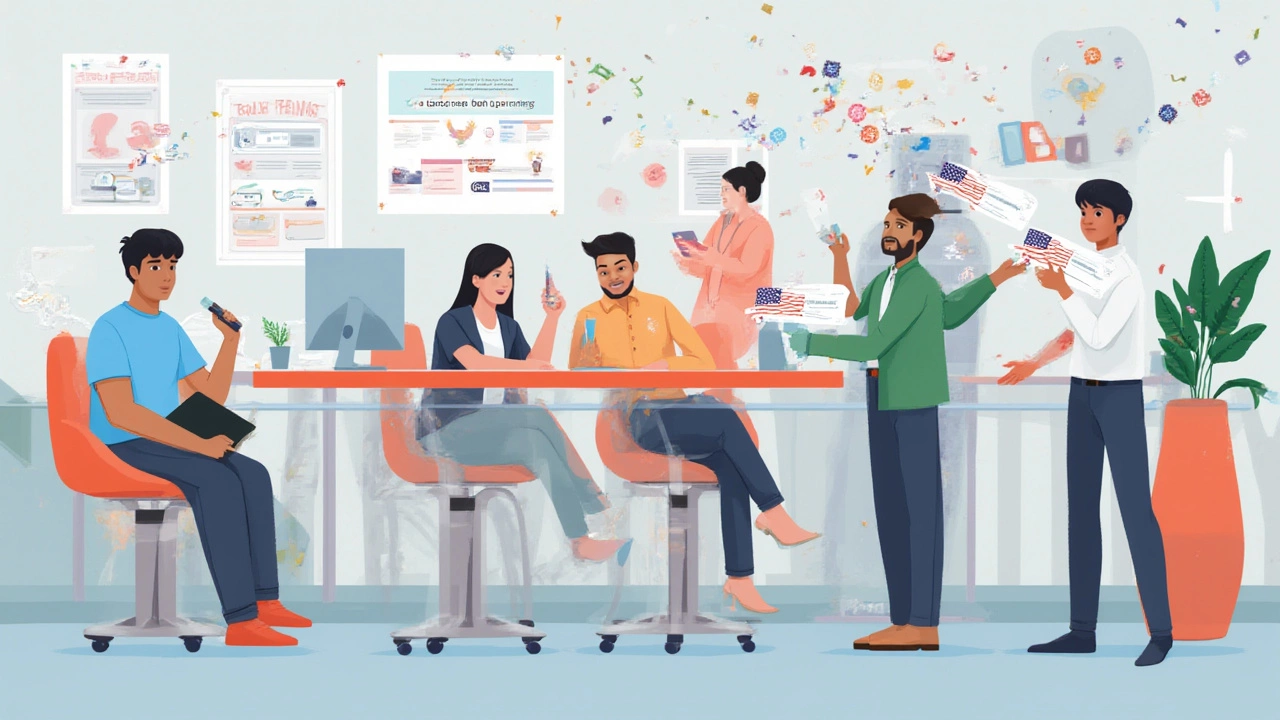Most people don't sit around wondering which federal department backs the country's lifeline for job training. But when layoffs spark anxiety, factories automate, or your kid says, "Should I go to trade school?", suddenly this question matters—a lot. America's workforce system is a patchwork, bigger and more active than most folks realize, and it's got way more going on than just handing out unemployment checks. We're talking billions spent every year helping people get new skills, land jobs, and power up their careers. If you've ever wondered who's really running the show behind the scenes, read on.
Meet the Main Player: The US Department of Labor
The US Department of Labor (DOL) is the powerhouse behind most job training programs across the country. Established back in 1913, the DOL wears a lot of hats, but its mission boils down to making work better and more accessible for everyone. Think of it as the quarterback on the workforce development field, calling plays and setting the strategy. Within the DOL, the Employment and Training Administration (ETA) specifically focuses on helping people train for, find, and keep good jobs. They're not just worried about people who are out of work, either—loads of their programs support low-income workers, veterans, young folks, and people with disabilities.
Take the Workforce Innovation and Opportunity Act (WIOA), one of the biggest federal laws shaping job training today. WIOA is kind of a catch-all for adult, youth, and dislocated worker programs. Congress funds all this through the Department of Labor, who then partners with state and local agencies to get the money and resources where they're needed. Here's a quick snapshot of how it's broken down:
| Program | Main Beneficiaries | 2024 Funding (USD) |
|---|---|---|
| WIOA Adult | Unemployed/Underemployed Adults | $900 million |
| WIOA Youth | Youth (ages 14-24) | $910 million |
| Dislocated Worker | Laid-off Workers | $1.3 billion |
But DOL's reach doesn’t stop there. The department also runs the Job Corps (for young adults who want comprehensive vocational training), the Senior Community Service Employment Program (for folks 55 and up), registered apprenticeships, and a bundle of grants targeted at veterans and people with disabilities. You might be surprised to learn the DOL oversees over 20 different workforce training programs.
According to the DOL’s official report for 2024, "Our programs helped nearly 3 million Americans access job training last year—more than 60% found a new job within six months of completing their program." That’s a pretty solid batting average.
Other Heavy Hitters: Departments That Pitch In
The Department of Labor might run the biggest show, but it's not the only federal agency making waves in workforce training. The US Department of Education plays a key supporting role, especially when it comes to career and technical education. Ever heard of Perkins V? That's the federal law that gives states millions each year to support technical education in high schools, community colleges, and technical centers. Thanks to Perkins funds, schools can buy new equipment, update old classes, and start new career pathway programs in fields like health care, IT, advanced manufacturing, and construction.
The Department of Veterans Affairs (VA) pitches in, too. Their Veteran Readiness and Employment (VR&E) Program helps veterans with service-connected disabilities find and keep jobs. The Department of Health and Human Services does its part for people who rely on Temporary Assistance for Needy Families (TANF). The Department of Housing and Urban Development, believe it or not, has job readiness initiatives for people in public housing. Even the Department of Agriculture runs job training for migrant and seasonal farmworkers. It’s like a giant Venn diagram—lots of overlap, but each department has its specialty.
- Department of Education: Perkins V, adult basic education, career technical education
- Department of Veterans Affairs: Vocational rehab for vets
- Department of Health and Human Services: TANF job readiness
- Department of Housing and Urban Development: Jobs Plus for public housing
- Department of Agriculture: Workforce for farmworkers
If you’re ever confused about which program or department to reach out to, a good tip is to start with your local American Job Center (AJC). These places are like one-stop shops connecting people to whichever program fits best, regardless of which department pays the bills.

Inside the Workforce Toolbox: What Do These Programs Really Offer?
Lots of folks imagine job training as someone in a classroom learning to fix car engines or run cables, but it’s actually a buffet of choices. Programs run by the Department of Labor and its partners offer way more than hands-on technical training. Here's what you usually get access to:
- Individual career guidance
- Help with writing resumes and job search coaching
- Paid work experience, like internships or apprenticeships
- Adult and youth literacy classes (for reading, math, ESL, even computer basics)
- Technical and trade certifications
- Tuition help for short-term or degree programs (especially for in-demand jobs)
- Interview coaching and networking with employers
- Sometimes even support like bus passes, work uniforms, or tools
About 80% of the money from WIOA goes straight to state and local workforce boards, who then decide which programs are a priority. The boards also work with local employers to figure out what kinds of jobs are actually in demand. For example, after COVID shook up the job market in 2020 and 2021, states started throwing more funds into healthcare job training, warehouse logistics, and IT support pathways.
It isn’t all government-driven, either. Big companies partner with the DOL to create registered apprenticeships in fields like cybersecurity, insurance, and advanced manufacturing. Apprenticeships combine paid on-the-job training with classroom studies. According to DOL data, over 241,000 new apprentices entered a program in 2024 alone. These aren’t just for high school grads—plenty of adults changing careers take this route because it pays while you train.
For those worried about dead ends, WIOA-funded programs are held to strict performance standards. If you finish a training course but don’t get placed in a job, those results reflect directly in funding decisions. Agencies are held accountable, and programs get dropped if they don’t deliver.
“The American workforce is the backbone of our economy. Our job training programs adapt to breakthrough industries and changing needs, not the other way around,” said Marty Walsh, former U.S. Secretary of Labor.
Who Actually Benefits—and How to Join In?
If you think these programs are just for people who are out of luck, think again. Sure, the unemployed get help, but so do:
- Young adults just starting out
- Veterans looking for civilian jobs
- Displaced workers after plant closures or automation
- People with disabilities trying to break into the workforce
- Folks switching careers later in life
- People rejoining after time away (family, prison, health issues)
Most services start at American Job Centers in your community. You walk in, fill out a quick assessment, and meet with a career counselor who can tell you which programs fit your goals, your needs, and your background. AJC staff can also help you score funding for tuition, connect you to employers, or sign you up for group workshops.
Don’t forget to check if your industry or region offers special grants. For instance, if you want to work in clean energy or healthcare (two red-hot fields right now), you may qualify for a program that covers nearly all costs. The Department of Labor also makes sure there are options for people whose first language isn’t English, parenting adults, and those with legal issues in their past.
If you’re nervous about paying bills while you train, ask about stipends or paid apprenticeships. A surprising number of programs will set you up with part-time paid experience while you’re in class. Community colleges often partner with these federal programs, too, so don’t count them out when you’re scoping opportunities.

Little-Known Facts, Actionable Tips, and How to Tap In
Here’s where things get practical. Want to actually take advantage of all this? Start local. Go to the CareerOneStop site—they’ll show you every American Job Center near you, plus a searchable map of federally funded job training programs in your area. Don’t assume you’re ineligible—check even if you’re employed, have a degree, or are mid-career. Over 40% of people getting training last year already had jobs but wanted better pay or opportunities.
If you want to skip the government process altogether, look for employer-sponsored apprenticeships and fast-track certification bootcamps. Many are still tied to public funding under the hood, but you can apply directly through employer websites. Companies like IBM, Amazon, and CVS have all expanded "earn while you learn" programs in partnership with the Department of Labor.
Here are some facts you might not know:
- More than 95% of American counties have at least one DOL-affiliated job training site.
- People who finish registered apprenticeships make an average of $77,000 a year upon completion, according to the DOL’s 2024 report.
- Job training grants often cover tools, uniforms, textbooks, and sometimes childcare—ask before you rule it out!
- You can find everything from coding to HVAC repair to digital marketing in these programs, because they partner with both old-school trades and emerging tech employers.
- Women and minorities now make up nearly 40% of new enrollments in federally backed job training—for real, things are changing fast.
If you’re stuck on what to pick, talk to employers directly. Ask HR reps what certifications or skills they value. Bring those answers to your job center or local college, and see what training fits. Skills are currency, and these programs are basically offering you free money to get more valuable in the job market.
Job training isn’t just for people in trouble or at a dead end—it’s a tool for anyone looking to get ahead, change lanes, or hedge against uncertainty in a world where work is always shifting. There’s never been more support for learning on the job, no matter where you start or where you want to end up. Give yourself a shot—you might be surprised by who’s ready to help.
